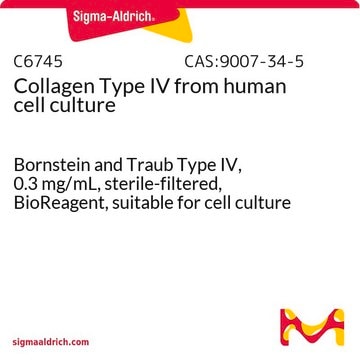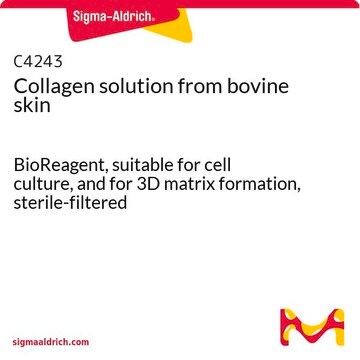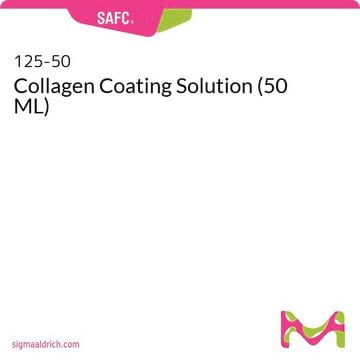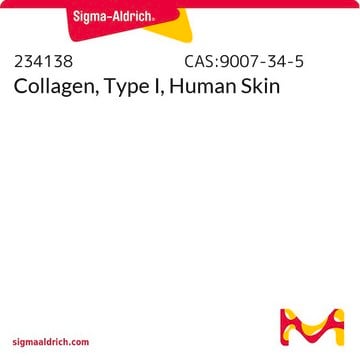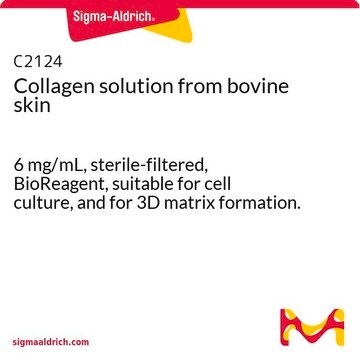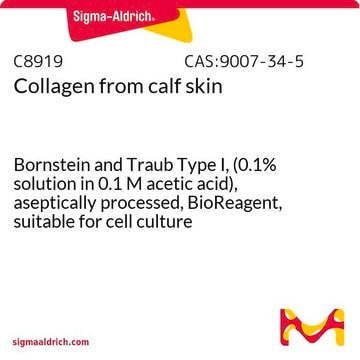As indicated above under 'PROPERTIES', this collagen solution is sterile-filtered.
C2249
Human Collagen Type I
from human fibroblasts, liquid, 3 mg/mL, suitable for cell culture
Synonyme(s) :
Collagen Solution, Fibroblast Collagen
Sélectionner une taille de conditionnement
Sélectionner une taille de conditionnement
About This Item
Produits recommandés
Nom du produit
Collagen Solution from human fibroblasts, 3 mg/mL, sterile-filtered, BioReagent, suitable for cell culture
Source biologique
human fibroblasts
Niveau de qualité
Stérilité
sterile-filtered
Gamme de produits
BioReagent
Forme
solution
Conditionnement
pkg of 20 mL
Concentration
3 mg/mL
Technique(s)
cell culture | mammalian: suitable
Couverture de surface
6‑10 μg/cm2
Spécificité de la liaison
Peptide Source: Collagen
Peptide Source: Elastin
Activité étrangère
endotoxin ≤5.0 μmole/min-mg protein
Conditions d'expédition
wet ice
Température de stockage
2-8°C
Description générale
Application
Actions biochimiques/physiologiques
Code de la classe de stockage
10 - Combustible liquids
Classe de danger pour l'eau (WGK)
nwg
Point d'éclair (°F)
Not applicable
Point d'éclair (°C)
Not applicable
Faites votre choix parmi les versions les plus récentes :
Déjà en possession de ce produit ?
Retrouvez la documentation relative aux produits que vous avez récemment achetés dans la Bibliothèque de documents.
Les clients ont également consulté
Articles
Extracellular matrix proteins such as laminin, collagen, and fibronectin can be used as cell attachment substrates in cell culture.
-
How did you steralize this collagen?
1 réponse-
Utile ?
-
-
Is this product suitable for 3D gel formation? How should it be neutralized? How quickly does it polymerize once neutralized? Is there a protocol available for 3D gel formation?
1 réponse-
Procedure for 3-D Gel Preparation:
1. Mix 8 parts of chilled collagen solution with 1 part of
10 X PBS (Catalog Number P5493 or P5368) or
10 X culture medium. Cells may be added following
this step.2. Adjust pH of mixture prepared in step 1 to 7.2–7.6.
Use of 0.1 M NaOH (10-fold dilution of Catalog
Number S2770) or 0.01 M HCl (100-fold dilution of
Catalog Number H9892) is recommended. Monitor
pH adjustment carefully with pH meter, phenol red,
or pH paper.3. To prevent gelation, maintain temperature of the
mixture at 2–8C. To form gel, warm to 37C. For
best results allow 45 minutes to 1 hour for gel
formation.4. The gels can be dried under a laminar flow hood.
Utile ?
-
-
Is the monomer a tropocollagen?
1 réponse-
The human collagen is secreted from fibroblast cells, which cleave the loose ends of the procollagen molecule, leaving what is considered tropocollagen with the telopeptide region intact. An enzyme step is utilized to cleave the telopeptide, resulting in Atelocollagen, which maintains its triple helical formation but without the telopeptide region.
Utile ?
-
-
What is the 2D Hydrogel protocol for Product No. C2249?
1 réponse-
There has been no internal protocol for C2249 however this paper describes protocol for 2D Collagen Gel. Hong H, Stegemann JP. 2D and 3D collagen and fibrin biopolymers promote specific ECM and integrin gene expression by vascular smooth muscle cells. J Biomater Sci Polym Ed. 2008;19(10):1279-93. doi: 10.1163/156856208786052380. PMID: 18854122; PMCID: PMC2731795.
Utile ?
-
-
Is this a monomer?
1 réponse-
This product is a mix of monomers, dimers, trimers, and oligomers, with some remaining collagen fragments.
Utile ?
-
-
What solvent is used for product C2249?
1 réponse-
The solvent for product C2249 is 13 mM HCl.
Utile ?
-
-
What is the acid, and concentration of acid, that the collagen is solubilized within?
1 réponse-
The acid used to prepare this product is HCl. The final concentration of the solvent is 13 mM.
Utile ?
-
Filtres actifs
Notre équipe de scientifiques dispose d'une expérience dans tous les secteurs de la recherche, notamment en sciences de la vie, science des matériaux, synthèse chimique, chromatographie, analyse et dans de nombreux autres domaines..
Contacter notre Service technique
